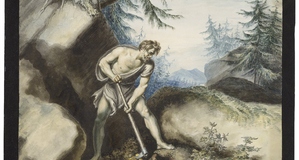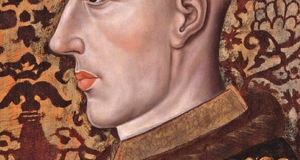Anton Chekhov and the Development of the Modern Character
By
2009, Vol. 1 No. 11 | pg. 1/1 Considered by some to be the father of the short story, Anton Chekhov created a paradigmatic form for writing fiction. By mimicking reality he produced a representational art through his stories. The revelations in Chekhov’s fictional characters transport the reader into all too familiar lives. Chekhov portrays such an honest reality through his characters and dialogue that he leaves his readers with perhaps a revelation within themselves. One of the most prominent literary elements in Chekhov’s work is that of character; he was a writer who had “great feeling for the inner emotions of his characters” (Freedman 1). This becomes evident through Ochumelov, a police inspector, in the story “Chameleon”. Ochumelov is walking through a marketplace when “all of a sudden the sound of a voice came to [his] ears”(Chekhov 1). After following the voice he discovers that it is Khryukin, who has come by the lumberyard to pick up wood. Khryukin claims to have been bitten by a stray dog and demands compensation and that the dog be shot. Ochumelov, now under the eye of an immense crowd of onlookers, immediately agrees with the complainant, pronouncing, “it’s time something [be] done about gentleman who are not willing to obey the regulations!”(Chekhov 2). But when someone in the crowd who has come to see what is going on suggests that the dog is the General’s, Ochumelov changes his attitude, now blaming Khryukin for the incident. Another onlooker then tells Ochumelov that the dog is in fact not the General’s, and again he changes his attitude, claiming that “the General’s dogs are expensive…and this one- just look at it! Ugly, mangy cur!”(Chekhov 2). Ochumelov goes on to change his mind every time someone suggests something different about the incident, only in order to protect what will be good for his self. He is worried only about his image as a public figure, each time making his decision based on how he thinks the crowd will perceive him. Ochumelov is the “perfect embodiment of human injustice and hypocrisy” (Freedman); he is a character that the reader will know without the use of a third person narrator. Chekhov advanced the form of character creation from a romantic focus to what is now the modern character. Charles E. May, a modern critic of Chekhov, explains “the short story is too short to allow for the character to be created by the kind of dense and social interaction through duration typical of the novel”(May 2). Chekhov understood this, and therefore avoids depicting the minds of his characters, instead letting the characters’ mood or feeling communicate their inner state. Conrad Aiken, perhaps the first critic to comment on Chekhov’s characterization, says that if the reader finds that the characters have a strange way of “evaporating, it is because our view of them was never permitted for a moment to be external”(May 2). Aiken is suggesting that when reading Chekhov, we no longer view the character objectively, but begin to see them “only as infinitely fine and truthful sequences of mood”(Aiken, as cited in May 2). That mood then becomes subjective, and we are brought into the lives of the character, instead of simply observing those lives as a spectacle.The development of Chekhov characterization is supported through his use of dialogue. Chekhov does not allow for the thoughts of Ochumelov, Krhyukin, or any other character of “Chameleon” to be divulged by any type of explicit narration; it is only through dialogue that those details are revealed. This technique of showing rather than describing was later given the term “objective correlative” by T.S. Eliot. The objective correlative is “a detailed event, description, or characterization that served as a sort of objectification or formula for the emotion sought for”(May 2). When Ochumelov first learns of the incident of the dog biting Khryukin, he exclaims that he will “teach people to let dogs run about!”(Chekhov 3). The next line is Ochumelov telling the officer with him to find out whose dog it is, and then a voice from the crowd shouts, “I think it belongs to General Zhigalov”(Chekhov 3). Ochumelov then tells the officer to help him off with his coat. With no narrative explanation of Ochumelov’s change in attitude, the following dialogue suddenly switches to blaming Khryukin for the incident: “You must have scathed your finger with a nail, and then taken it into your head to get paid for it. I know you fellows! A set of devils!”(Chekhov 3). The dialogue in itself is enough for the reader to understand the change in mood of Ochumelov, and no narration is necessary. The only way Chekhov includes his voice in his stories is by writing them from his own experiences. The stories that occur within Chekhov’s characters are drawn from the author’s own life. That is not to say that Chekhov witnessed an event such as that in “Chameleon”, or rode in Iona’s cab from “Misery”; it simply means that his own life experiences inspired the creativity that produced these pieces, and were perhaps evident in his characters. In “The Lady with The Dog”, Gurov, the protagonist, pursues an idealised love. Virginia Llewellyn Smith, a Chekhov critic, believes that Anna Sergeyevna, the woman Gurov meets and falls in love with, “can be considered symbolic of the ideal love that Chekhov could envisage but not embrace.”(Eekman, Smith 118). And there is evidence more tangible than this, such as the fact that the reader is told that Gurov “was not yet forty”: Chekhov was 39 when he wrote “The Lady With the Dog” (Smith 1, as Cited in Eekman). The “real life” experiences that are portrayed in his characters make them accessible to the reader; they are not romanticized; they remain ordinary. Chekhov’s method of writing is similar to good acting. When an actor is on stage, and wants to be viewed as more than a spectacle- as a medium, which will evoke emotion from the audience- they must authentically feel how their role is intended to feel. Peter Brook wrote in his book The Empty Space, “If the beginner playwright often seems thin, it may well be because his range of human sympathy is still unstretched…”(Brook 33); that is to say, how can an author write about something they have yet to experience? Chekhov can evoke emotions through his stories because he writes honestly. Just as we sympathize with an actor who is truly sad on stage, we sympathize with a character of Chekhov’s who is truly sad in text. Bloom, Harold, ed. Modern Critical Views Anton Chekhov. Comp. Charles E. May. Philadelphia: Chelsea House, 1999. Print. Brook, Peter. The Empty Space. New York: Simon and Schuster, 1968. Print. Eekman, Thomas A., and Virginia L. Smith. Critical Essays on Anton Chekhov. Ed. Robert Lecker. Boston: G.K. Hall and Co., 1989. Print. Eliot, T.S. The Sacred Wood; essays on poetry and criticism. London: Methune, 1920. Print. Matlaw, Ralph E., and Freedman, comps. Anton Chekhov's Short Stories. New York, London: W.W. Norton and Company, 1979. Print. Suggested Reading from Inquiries Journal
Inquiries Journal provides undergraduate and graduate students around the world a platform for the wide dissemination of academic work over a range of core disciplines. Representing the work of students from hundreds of institutions around the globe, Inquiries Journal's large database of academic articles is completely free. Learn more | Blog | Submit Latest in Literature |
















